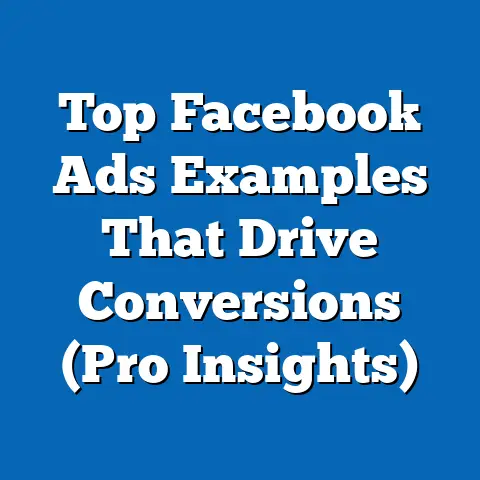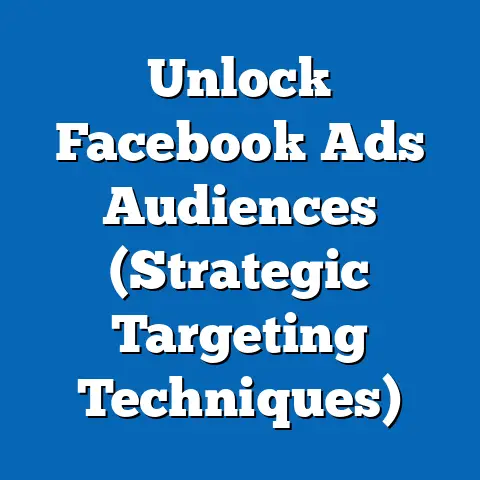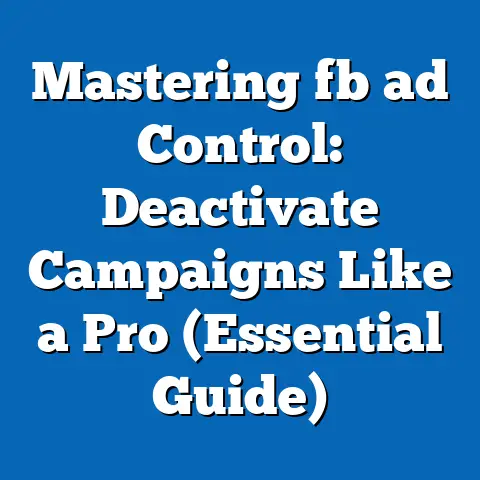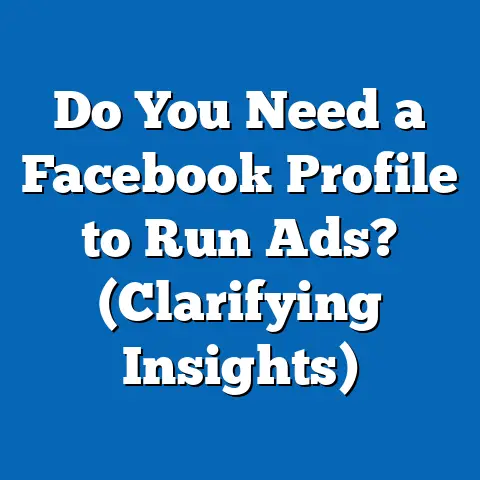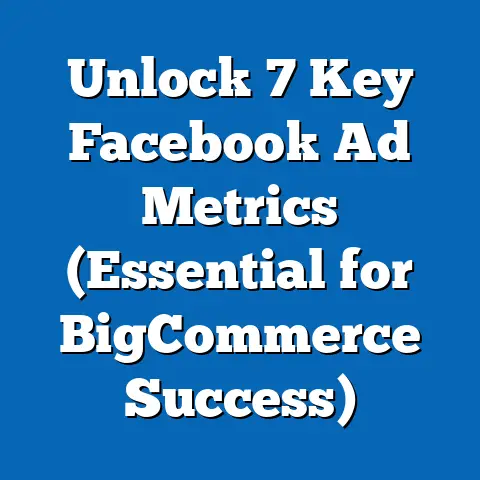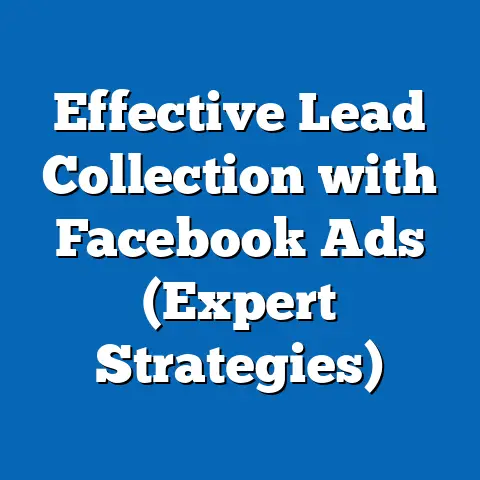Transform Facebook Ads: Proven Success Strategies (Must-See Insights)
As we stand at the precipice of a new era in digital marketing, the landscape of social media advertising continues to evolve at a breakneck pace. Facebook, now under the broader umbrella of Meta, remains a dominant force in this space, commanding a user base of over 2.9 billion monthly active users as of 2023 (Statista, 2023). With such a vast audience, the platform offers unparalleled opportunities for businesses to connect with consumers—but only if they can adapt to the shifting tides of technology, user behavior, and generational preferences.
Looking to the future, the transformation of Facebook ads will be driven by advancements in artificial intelligence (AI), changing privacy regulations, and the growing influence of younger generations like Gen Z and the emerging Gen Alpha. These factors will redefine how brands craft campaigns, target audiences, and measure success. This article delves into proven strategies for navigating these changes, offering must-see insights for advertisers aiming to stay ahead of the curve.
Section 1: The Future of Facebook Ads—Key Defining Characteristics
1.1 AI-Driven Personalization and Automation
The future of Facebook advertising is inextricably linked to AI and machine learning. Meta has already rolled out tools like Advantage+ campaigns, which use AI to automate ad placement, creative optimization, and audience targeting. According to Meta’s own reports, businesses using Advantage+ campaigns have seen a 20% improvement in cost-per-acquisition on average (Meta, 2023).
AI will only grow more sophisticated, predicting user behavior with greater accuracy and delivering hyper-personalized content in real time. However, this raises questions about user privacy and the ethical use of data—issues that will shape the trajectory of ad tech in the coming years.
1.2 Privacy-First Advertising
With Apple’s iOS 14.5 update in 2021 introducing App Tracking Transparency (ATT) and the impending deprecation of third-party cookies on Google Chrome by 2024, privacy concerns are at the forefront of digital advertising. Facebook has faced significant challenges due to these changes, with Meta estimating a $10 billion revenue loss in 2022 alone due to ATT (Reuters, 2022).
Future ad strategies will need to prioritize first-party data collection, contextual targeting, and privacy-compliant solutions. Marketers will have to pivot toward building trust with consumers, emphasizing transparency in how data is used.
1.3 The Rise of Immersive Formats
As younger generations demand more engaging content, formats like augmented reality (AR) ads, interactive Stories, and shoppable posts will dominate. Meta’s investment in the metaverse signals a long-term vision for immersive advertising experiences. A 2022 survey by eMarketer found that 62% of Gen Z users are more likely to interact with AR ads compared to traditional formats.
These formats will require advertisers to rethink creative strategies, focusing on interactivity and gamification to capture attention in a crowded digital space.
1.4 Generational Shifts in User Behavior
Gen Z (born 1997-2012) and the emerging Gen Alpha (born 2013-2025) are redefining social media consumption. Unlike Millennials, who grew up with the early internet, these cohorts are digital natives with high expectations for authenticity and social responsibility from brands. A 2023 study by Morning Consult revealed that 74% of Gen Z users value brands that align with their values, such as sustainability and diversity.
Future Facebook ad strategies must cater to these preferences, balancing entertainment with purpose-driven messaging to resonate with younger audiences while retaining older demographics like Gen X and Baby Boomers.
Section 2: Historical Context—How Facebook Ads Evolved
2.1 The Early Days of Social Advertising (2007-2012)
Facebook launched its first ad platform, Facebook Ads, in 2007, introducing a novel concept: social advertising. Unlike traditional banner ads, these early campaigns leveraged users’ social connections, displaying ads based on friends’ likes and interactions. This era was defined by experimentation, with businesses testing the waters of a platform that was primarily seen as a social networking site rather than a marketing tool.
The introduction of the News Feed in 2006 and subsequent ad placements within it marked a turning point. By 2012, Facebook’s IPO and the launch of mobile ads capitalized on the growing smartphone market, setting the stage for exponential growth.
However, this period also brought scrutiny. The 2018 Cambridge Analytica scandal exposed the dark side of data harvesting, leading to public outcry and regulatory action like the General Data Protection Regulation (GDPR) in Europe.
2.3 The Privacy Pivot and Beyond (2019-Present)
Post-2018, Facebook faced increasing pressure to reform its data practices. The platform introduced measures like the “Clear History” tool and pivoted toward privacy-focused innovations. Meanwhile, the rise of short-form video content, spurred by competitors like TikTok, pushed Meta to prioritize Reels and dynamic ad formats.
The historical trajectory of Facebook ads underscores a key lesson: adaptability is critical. Marketers who succeeded were those who embraced emerging technologies and responded to societal shifts, a principle that remains relevant as we look to the future.
Section 3: Societal Implications of Evolving Facebook Ads
3.1 Economic Impacts
Facebook ads have democratized marketing, enabling small businesses to compete with larger corporations on a relatively level playing field. A 2022 study by Deloitte found that Meta’s platforms contributed $1.1 trillion to global economic activity, with small and medium-sized enterprises (SMEs) benefiting significantly from low-cost advertising options.
However, as ad costs rise—average cost-per-click increased by 17% from 2021 to 2023 (WordStream, 2023)—there’s a risk of excluding smaller players. Future strategies must balance affordability with advanced targeting capabilities to maintain economic inclusivity.
3.2 Cultural Shifts
Advertising on Facebook influences cultural norms by shaping consumer behavior and societal values. Campaigns promoting diversity, equity, and inclusion (DEI) have gained traction, reflecting broader cultural movements. For instance, brands like Nike and Dove have used Meta platforms to champion social causes, resonating with younger, socially conscious audiences.
Yet, the risk of “performative activism” looms large. Ads that lack authenticity can backfire, alienating consumers who demand genuine commitment over marketing ploys.
3.3 Workplace Dynamics
The evolution of Facebook ads also impacts how marketing teams operate. The shift toward AI and automation requires upskilling employees in data analytics and creative tech tools. A 2023 LinkedIn report noted a 25% increase in demand for digital marketing roles with AI expertise since 2020.
This trend could exacerbate generational divides in the workplace, as younger workers may adapt more readily to new technologies compared to older colleagues. Companies will need to invest in training to bridge this gap.
3.4 Ethical Considerations
The future of Facebook ads raises ethical questions about surveillance capitalism and the psychological impact of targeted advertising. Studies, such as one from the American Psychological Association (2021), suggest that hyper-targeted ads can contribute to anxiety and decision fatigue among users.
As AI becomes more pervasive, advertisers must navigate the fine line between personalization and manipulation, ensuring campaigns prioritize consumer well-being over profit.
Section 4: Proven Success Strategies for Transforming Facebook Ads
4.1 Leverage AI for Optimization
To stay competitive, advertisers must embrace AI-driven tools like Meta’s Advantage+ suite. Start by testing automated campaigns with small budgets to understand how algorithms optimize for your goals. Focus on feeding the system high-quality creative assets—dynamic images, videos, and copy—to maximize performance.
Data from Social Media Today (2023) shows that brands using AI-optimized ads achieve a 30% higher return on ad spend (ROAS) compared to manual campaigns. However, human oversight remains crucial to ensure brand alignment and ethical considerations.
4.2 Prioritize First-Party Data
With third-party tracking on the decline, building a robust first-party data strategy is non-negotiable. Encourage users to opt into email lists, loyalty programs, or direct engagement through lead forms and quizzes on Facebook. Use Meta’s Conversions API to track user actions without relying on cookies, ensuring compliance with privacy regulations.
A 2022 Forrester report found that brands with strong first-party data strategies saw a 2.9x increase in customer lifetime value. Transparency in data collection will also foster trust, a critical factor for long-term success.
4.3 Create Immersive and Interactive Content
Invest in AR filters, 360-degree videos, and shoppable ads to captivate younger audiences. Collaborate with creators to produce authentic content that feels native to the platform. For example, brands like Sephora have used AR try-on ads to drive a 31% higher engagement rate among Gen Z users (Meta Case Study, 2022).
Test interactive formats in Stories and Reels, as these placements often yield higher click-through rates (CTR) compared to static posts. Keep content concise and visually striking to stand out in a crowded feed.
4.4 Segment Audiences by Generational Values
Tailor messaging to the unique values of each generation while avoiding stereotypes. For Gen Z, focus on authenticity, humor, and social impact—think short, snappy videos with a purpose. Millennials, often in their peak earning years, respond well to value-driven offers and nostalgia-based content.
Older generations like Gen X and Baby Boomers may prioritize trust and reliability, so emphasize customer testimonials and clear calls-to-action. A 2023 Pew Research study highlights that cross-generational campaigns can work if they focus on universal themes like family or community.
4.5 Measure Success Beyond Traditional Metrics
As privacy changes limit tracking, redefine success metrics to include engagement, brand lift, and customer sentiment. Use Meta’s Brand Lift studies to gauge how ads influence perception over time. Incorporate qualitative feedback through polls and comments to understand audience reactions.
A 2022 study by Nielsen found that 64% of marketers plan to shift focus from clicks to brand-building metrics in the next five years. This holistic approach ensures long-term impact over short-term gains.
4.6 Test and Iterate Continuously
The digital ad space is too dynamic for a “set it and forget it” mentality. Run A/B tests on creative elements, audience segments, and placements to identify what resonates. Use Meta’s split-testing tools to compare variables like ad copy or visuals with minimal budget risk.
According to HubSpot (2023), brands that test at least monthly achieve 37% higher campaign efficiency. Stay agile, adapting to platform updates and cultural trends to maintain relevance.
Section 5: Nuances and Diversity in Audience Responses
It’s critical to acknowledge that not all users within a generation or demographic respond identically to Facebook ads. Factors like socioeconomic status, geographic location, and personal interests create significant variation. For instance, rural Gen Z users may prioritize affordability over trendy aesthetics compared to their urban counterparts.
Cultural context also plays a role—ads that resonate in Western markets may not translate effectively in Asia or Africa without localization. A 2023 McKinsey report emphasized that culturally relevant campaigns drive 3x higher engagement globally. Marketers must invest in nuanced research to avoid alienating diverse audiences.
Moreover, accessibility remains an often-overlooked factor. Ensuring ads are inclusive—through captions for videos, alt text for images, and colorblind-friendly designs—broadens reach and demonstrates social responsibility.
Section 6: Implications Across Domains
6.1 For Society
The transformation of Facebook ads will continue to shape societal discourse, amplifying voices on critical issues like climate change or mental health. However, the risk of echo chambers persists as algorithms reinforce existing beliefs. Advertisers have a responsibility to promote balanced narratives, avoiding divisive or polarizing content.
6.2 For Culture
As ads become more immersive, they’ll blur the line between entertainment and marketing, influencing cultural consumption. This could lead to richer storytelling but also raises concerns about consumerism overshadowing authentic cultural expression. Brands must strike a balance, contributing positively to cultural dialogues.
6.3 For the Workplace
The demand for digital marketing expertise will reshape hiring trends, with a premium on hybrid skills combining creativity and tech proficiency. Companies must foster inclusive environments where multi-generational teams collaborate, leveraging diverse perspectives to innovate ad strategies.
6.4 For Technology
Advancements in AI and AR will push the boundaries of what’s possible in advertising, but they’ll also necessitate stricter regulations to prevent misuse. Collaboration between tech companies, policymakers, and advertisers will be essential to create a sustainable ecosystem.
Section 7: Forward-Looking Insights and Uncertainties
Looking ahead, the future of Facebook ads is both promising and uncertain. On one hand, AI and immersive tech offer exciting opportunities to redefine engagement, potentially creating a more connected, personalized digital world. On the other, privacy concerns, regulatory scrutiny, and platform fatigue among younger users could challenge Meta’s dominance.
Will the metaverse become the next frontier for advertising, or will it remain a niche experiment? How will global economic trends, like inflation or recession, impact ad budgets and consumer behavior? These questions remain unanswered, but one thing is clear: adaptability will be the cornerstone of success.
Marketers must stay informed, embracing emerging tools while grounding strategies in ethical principles. By focusing on transparency, creativity, and audience-centricity, brands can navigate uncertainties and transform challenges into opportunities.
Conclusion
As we move forward, the interplay between innovation and responsibility will define the next chapter of digital advertising. By leveraging proven strategies and remaining attuned to generational and cultural nuances, marketers can harness the power of Facebook ads to build meaningful connections. The future is unwritten, but with insight and agility, brands can shape it for the better.

